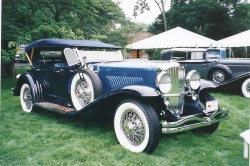 1929 Duesenberg Model J. Click image to enlarge |
Article and photo by Bill Vance
Among the thousands of automobile nameplates throughout history, America’s Duesenberg J and SJ ranked with the world’s best. They were the equal of such legendary marques as England’s Rolls-Royce, Germany’s Mercedes-Benz, France’s Bugatti, Italy’s Isotta-Fraschini and Spain’s Hispano-Suiza.
The J and SJ were the creation of German-born Fred and August Duesenberg, who came to America as children in the late 1800s. Growing up in Iowa, they were keen cyclists with enough natural mechanical talent to build their own race-winning bicycles.
With the emergence of motorized vehicles, the brothers were soon dabbling in motorcycles and cars. In 1906, with backing from a Des Moines lawyer named Mason, they began production of the Mason car, a good performer that won hill climbs and races. The company prospered and in 1910 was bought out by the Maytag Company, better known for washing machines than for cars.
By 1913 the Duesenbergs were able to organize their own Duesenberg Motor Company in St. Paul, Minnesota, to build automobile and marine engines. They were soon producing successful racing cars that were made famous by such legendary driving greats as Eddie Rickenbacker and Ralph Mulford.
This attracted New York capital and in 1916, a $1.5 million venture was organized and a huge factory constructed for the Duesenberg Motors Corp. in Elizabeth, New Jersey. This was during the First World War, and car building was delayed while the plant turned out aero engines.
When the war ended in 1918 the brothers returned to the car-building venture with a four-cylinder engine, but their hearts weren’t really in it. This led to their departure, leaving them free to concentrate on their real love, an eight-cylinder overhead camshaft racing engine.
By the early 1920s they were back in business as the Duesenberg Automobile and Motor Corp. in Indianapolis, Indiana. They built some 600 Model A Duesenbergs, powered by a detuned version of their straight-eight racing engine, but these were not profitable. The Duesenbergs proved to be better engineers than they were businessmen.
Then, in 1926, events evolved that would establish the Duesenberg name at the pinnacle of the automotive world. Errett Lobban Cord, president of the Auburn Automobile Co. in Auburn, Indiana, bought the Duesenberg company and asked the brothers to design a mighty motorcar that would match the world’s finest marques.
It was the kind of challenge the Duesenbergs loved, and the result was the Model J Duesenberg introduced in December, 1928 at the New York Automobile Salon. It had a whopping 3,619 mm (142.5 in.) wheelbase, and even longer wheelbases would be offered later. Weight varied with the type of coachwork, but was in the 2,268 to 2,722 kg (5,000 to 6,000 lb) range. Duesenbergs were bodied in a wide variety of styles by some of the finest coachbuilders of the era, including Murphy, Locke, Derham and Le Baron.
The J had a race-inspired straight-eight engine with chain-driven double overhead camshafts actuating four valves per cylinder. It displaced 6.9 litres (420 cu in.) and was rated at 265 horsepower at 4,200 rpm. The J was fitted with hydraulic brakes, which Duesenberg had pioneered in the Model A Duesenberg; they were vacuum assisted to help haul the heavy car down from high speeds.
Performance was prodigious. In November 1956, Road & Track magazine carried a simulated road test of a 1930 Duesenberg J coupe. It was not based on the test of an actual car, but relied on past associations with Duesenbergs, plus earlier published data and some educated “guestimates.”
The magazine estimated that the J could accelerate from zero to 96 km/h (60 mph) in 8.6 seconds and reach a top speed of 185 km/h (115 mph) in third (high) gear, with 153 km/h (95 mph) available in second. The high-gear top speed seems in line with other reports, although the second-gear speed and acceleration times may have been a bit optimistic.
What was more important in that pre-automatic transmission era was the ability to accelerate and climb hills in high gear. Road & Track estimated that the engine’s high, flat torque curve could propel the car from 16 to 129 km/h (10 to 80 mph) in high in just 22 seconds.
The J was joined in 1932 by the even mightier supercharged Duesenberg SJ, rated at 320 horsepower. This was said to be capable of 167 km/h (104 mph) in second gear and 225 km/h (140 mph) in high. Racing great Ab Jenkins hit 258 km/h (160 mph) in an SJ.
Unfortunately, the Duesenberg J was introduced shortly before the onset of the Depression. In spite of this, Duesenbergs continued to be produced and sold until 1937, then disappeared with the death of the Cord empire. A total of 470 Js and SJs had been built.
Thankfully, many of these super automobiles have been preserved to remind us of an era when American cars were the equal of the world’s best.








